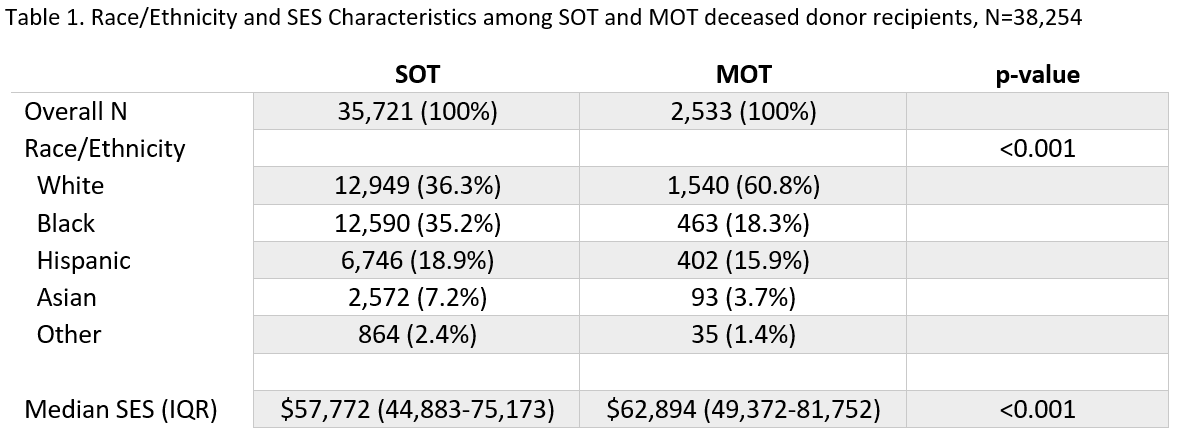Racial/Ethnic and Socio-Economic Disparities: Single versus Multi-Organ Transplant Recipients
1United Network for Organ Sharing, Richmond, VA, 2Tufts University, Medford, MA, 3Thomas Jefferson University, Washington, DC, 4Northwestern University, Chicago, IL
Meeting: 2019 American Transplant Congress
Abstract number: 216
Keywords: Allocation, Ethics, Kidney transplantation
Session Information
Session Name: Concurrent Session: Kidney Deceased Donor Allocation II
Session Type: Concurrent Session
Date: Monday, June 3, 2019
Session Time: 2:30pm-4:00pm
 Presentation Time: 3:30pm-3:42pm
Presentation Time: 3:30pm-3:42pm
Location: Ballroom B
*Purpose: Under current deceased donor kidney allocation policy, multi-organ transplant (MOT) candidates often receive priority over single organ transplant (SOT) candidates. We examined the distribution of race/ethnicity and socio-economic status (SES) characteristics among SOT and MOT recipients.
*Methods: The OPTN/UNOS Ethics Committee analyzed OPTN data to identify all deceased donor kidney recipients from 2015-2017. Kidney-pancreas recipients were excluded. Characteristics of interest across multi-organ status (SOT vs. MOT) were race/ethnicity (white, black, Hispanic, Asian, other) and SES (measured by the median income of the recipient’s permanent ZIP code), and compared via statistical tests. An analysis of the next candidate on the kidney match list was performed for the same time period. For this we identified deceased kidney donors that donated both kidneys, with one going to a SOT recipient and one going to a MOT recipient. Since MOT kidney candidates do not appear on the kidney match run, we examined the candidate listed after the SOT kidney recipient to characterize patients affected my MOT allocation.
*Results: Race/ethnicity differed significantly between SOT and MOT recipients (p<0.001). Black recipients represented 35.2% of SOT recipients and 18.3% of MOT recipients. Conversely, white recipients represented 37.9% of SOT recipients and 60.8% of MOT recipients. SES also significantly differed between SOT and MOT recipients (p<0.001). The next candidate analysis (N=1694) revealed that black candidates were the largest next candidate subgroup (39.0%), followed by white candidates (32.6%) and Hispanic candidates (21.1%).
*Conclusions: Our findings suggest that SOT versus MOT recipients differ significantly by race/ethnicity and socioeconomic characteristics. These differences are most apparent for black recipients. MOT recipients had a higher SES than SOT recipients. Although statistically significant, the absolute magnitude difference for SES between SOT and MOT recipients was not meaningful. The implications of these disparities remain unclear. Further analysis should quantify these characteristics amongst all kidney waiting list candidates to provide greater insight to our findings.
To cite this abstract in AMA style:
Custer CA, Ladin K, Entwistle J, Gordon EJ. Racial/Ethnic and Socio-Economic Disparities: Single versus Multi-Organ Transplant Recipients [abstract]. Am J Transplant. 2019; 19 (suppl 3). https://atcmeetingabstracts.com/abstract/racial-ethnic-and-socio-economic-disparities-single-versus-multi-organ-transplant-recipients/. Accessed December 17, 2025.« Back to 2019 American Transplant Congress

